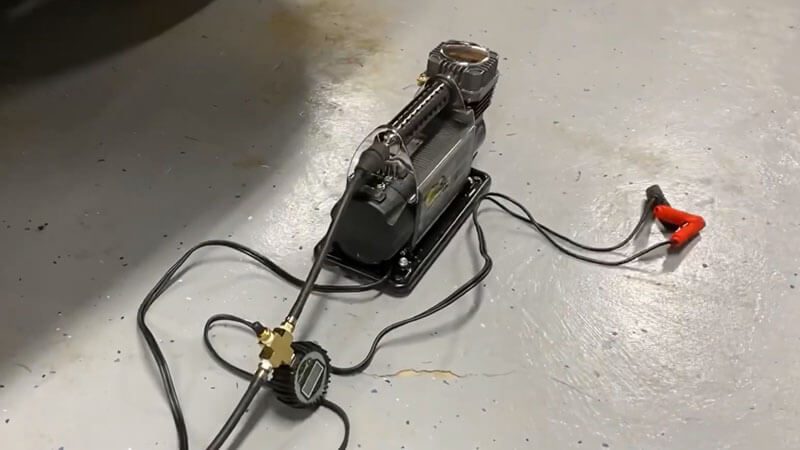Attaching a tire inflator to an air compressor seems like a daunting task, especially if you have never done it before. However, it becomes a quick and easy process with the right tools and a bit of know-how.
The kind of air hose you’re using will determine how you attach an inflator to the air compressor. With a quick fitting, it’s easier to attach the inflator. Anyway, if the nozzle size and type differ, you have to adjust the attachment.
So, whether you’re a car enthusiast or just need to inflate your tires for everyday use, this detailed guide will provide you with the information you need to get the job done. Thus, grab your tools, and let’s get started!
How To Attach A Tire Inflator To An Air Compressor?
Attaching a tire inflator to an air compressor is simple, provided you have the correct tools and proper guidelines.
Gather Required Tools
Some basic tools are needed to install a tire inflator to an air compressor. These are stated below:
- Two adjustable wrenches
- Teflon tape
- Air chuck (if needed)
- Male-to-female adapter (if needed)
- Tire inflator device (⅜”, ¼” NPT fitting)
Connecting Air Hose to Air Compressor
First, locate the air outlet on your air compressor. A metal or plastic fitting is typically attached to the compressor’s side. Attach the air hose to the air outlet on the compressor.
If the air hose has a quick-fitting nozzle (¼”NPT), it will directly connect to the outlet. Otherwise, you need to screw it in by rotating clockwise.
Attaching Tire Inflator to Air-Hose Outlet
Now, the other end of the air hose is an outlet for the tire inflator. Check the type of inlet hose in your tire inflator. Screw in a two-way adapter if modification is required. Wrap enough Teflon tape to secure the adapter connection and avoid leakage.
Now insert the inlet nozzle into the adapter. Use the wrenches in the opposite direction for a strong connection. Ensure the tire inflator valve is well attached to the inlet side.
Afterward, put the inlet side of the tire inflator to the outlet end of the air hose from the air compressor. If the outlet design belongs to a quick-fitting type, simply insert the nozzle, and it shall get locked in.
On the contrary, for an analog connection, wrap the air hose with Teflon, then screw in the nozzle from the tire inflator.
Securing Inflator to Air Compressor Attachment
Turn on the air compressor and build up pressure as per the user’s manual. Generally, 80-90 psi of pressure is recommended for the air compressor for car and bike tires.
Next, release the valve in the air compressor and press the pin inside the air chuck of the tire inflator. Keep an eye on the pressure gauge to see if the air pressure is delivered satisfactorily.
What Type of Hose and Fittings Do You Need to Connect a Tire Inflator to An Air Compressor?
Nowadays, many nozzles, hoses, and fitting adapters are available to connect a tire inflator to an air compressor. Mainly two types of fittings are seen: quick fitting and manual fitting.
However, it depends upon the manufacturing company and the type of fitting they provide for the air compressor or tire inflator. The basic type of hose and fittings are stated below:
Required Air Hose Type
The air hose should be made of durable materials, such as rubber or polyurethane, to withstand the pressure and temperature changes within the hose.
It is also recommended to use a hose that is resistant to kinking, cracking, and abrasion. The hose should be long enough to reach your vehicle’s four tires.
Fitting Types
The fittings are the connectors that join the hose to the tire inflator and air compressor. The fittings should be made of durable materials such as brass or steel, and they should be designed to fit the specific models of the tire inflator and air compressor.
Usually, a fitting with ⅜” or ¾” inner diameter is used for tire inflators and air compressors. The outlet side should be compatible with ¼” NPT fitting.
How Do You Know If the Tire Inflator is Properly Connected to The Air Compressor?
It is essential to ensure all fitting connections within the tire inflator, and air compressor is properly adjusted. You might follow the below-stated signs before using the air compressor.
1. Secure And Strong Fit
You must ensure that the air hose and fittings should be securely connected to the tire inflator and air compressor with no leaks or loose connections.
2. Consistent Air Flow
When the air compressor is turned on, you should be able to hear and feel the air flowing through the hose and into the tire inflator. Check the air chuck to feel the thrust due to air ejection.
3. Correct Pressure Reading
The gauge on the tire inflator should register the correct pressure level as the air compressor is running. You can also use an analog pressure gauge to check the pressure manually.
4. No Hissing noise or Vibration
If you hear a hissing noise, it could be a sign of a leak or a loose connection. Use Teflon tape to avoid such occurrences.
The tire inflator should not vibrate or shake excessively, which could indicate a problem with the connection or the compressor itself.
5. Negligible Overheating
The hose or fittings shouldn’t be overheating during use; this indicates a problem with the airflow and abnormal pressure.
FAQ
Follow these FAQs from the users to acknowledge more about connecting a tire inflator to an air compressor.
Tire inflators and air compressors are two different devices. Tire inflators possess an air chuck and pressure gauge especially designed for different vehicular tires. Air hoses with ¼” NPT nozzles are connected to an air compressor.
Most air compressor attachments have ⅜” thread and ¼” NPT fitting size. However, in some regions, the nozzle type and size could differ based on manufacturing company policy.
For tires, the pressure in the air compressor should be adjusted between 80-90 psi. Higher pressure might over-inflate the tires and cause accidents.
On average, it takes about 5-10 minutes to inflate a standard car tire using a household air compressor and tire inflator. However, larger tires or tires requiring higher air pressure may take longer.
A small portable air compressor with a tank capacity of at least 3 gallons at 90 PSI (pounds per square inch) will work well for a standard passenger car tire. Moreover, air compressors with a 5-gallon capacity are also suitable for inflating any type of tire
Final Words
Connecting a tire inflator to an air compressor can be troublesome for newbies. Before installation, you must check all the attachments, such as the inflator and air hose fittings, air chuck, etc., are compatible with the air compressor.
For new users, it is recommended to use a quick universal fitting (¼” NPT) enabled air hose for attaching the tire inflators. It avoids the hassle of using wrenches and adaptors.
We hope the article has presented you with informative guidelines and eases the job of attaching a tire inflator to an air compressor.

